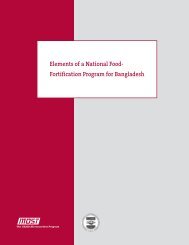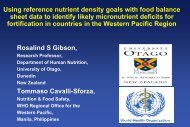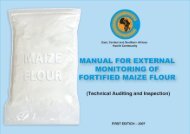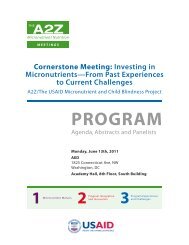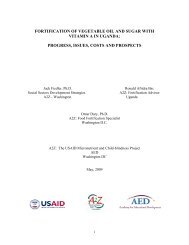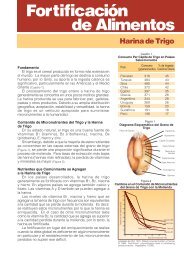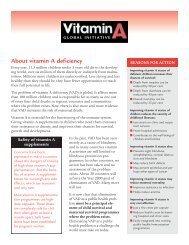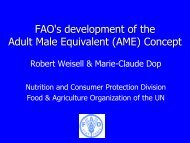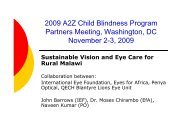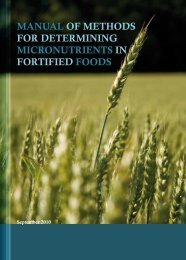Manual of Labratory Methods for Fortified Foods - Part II - A2Z: The ...
Manual of Labratory Methods for Fortified Foods - Part II - A2Z: The ...
Manual of Labratory Methods for Fortified Foods - Part II - A2Z: The ...
You also want an ePaper? Increase the reach of your titles
YUMPU automatically turns print PDFs into web optimized ePapers that Google loves.
AcknowledgementThis <strong>Manual</strong> has been developed by the ECSA Health Community Secretariat with technical and financial assistance from the Academy<strong>for</strong> Educational Development through <strong>A2Z</strong>: <strong>The</strong> USAID Micronutrient and Child Blindness Project (GHS-A-00-05-00012).<strong>The</strong> manual is as a result <strong>of</strong> joint work by distinguished food <strong>for</strong>tification experts in developing countries. During the drafting <strong>of</strong> this manual,consultations with senior <strong>of</strong>ficers from food control departments <strong>of</strong> the ECSA member states were made and input incorporated.About the AuthorsMonica Guamuch: A Guatemalan food <strong>for</strong>tification consultant with experience in Latin American and the Caribbean.Phillip Makhumula: A Malawian food <strong>for</strong>tification consultant with experience in Africa and Central Asia.Omar Dary (PhD): <strong>The</strong> Food Fortification Specialist <strong>of</strong> <strong>A2Z</strong>: <strong>The</strong> USAID Micronutrient and Child Blindness Project.ECSA is deeply thankful to the above authors <strong>for</strong> preparing this manual.Disclaimer<strong>The</strong> content <strong>of</strong> this manual can be adapted to suit country specific contexts. In such a case, the content <strong>of</strong> the resulting document will be the sole responsibility <strong>of</strong>the organization adapting the manual and will not represent the views <strong>of</strong> the authors and that <strong>of</strong> the ECSA-HC. <strong>The</strong> Use <strong>of</strong> the content <strong>of</strong> this manual should be dulyacknowledged.(ii)
(A). DEFINITIONS OF ASSAY PARAMETERS AND GENERAL DESCRIPTION OF THE ANALYTICALMETHODSI. ASSAY PARAMETERSIn this manual, the following definitions are used to characterize the per<strong>for</strong>mance <strong>of</strong> the analytical assays:Specificity2 is the ability <strong>of</strong> a method to respond exclusively to the target analyte and not to any degrading impurity, or other component<strong>of</strong> the matrix. Since very few methods are absolutely specific, so the term selectivity is <strong>of</strong>ten used <strong>for</strong> this property and is defined as thedegree to which a method can quantify the analyte (i.e. the micronutrient <strong>of</strong> interest) accurately in the presence <strong>of</strong> interferents3. <strong>The</strong>smallest quantity <strong>of</strong> the analyte that can be distinguished from the background response or analytical noise by the method is known as thelimit <strong>of</strong> detection.Sensitivity4 is defined <strong>for</strong> the purpose <strong>of</strong> this manual as the degree <strong>of</strong> certainty that an analytical assay can differentiate between two verysimilar amounts <strong>of</strong> the analyte. <strong>The</strong> minimum amount <strong>of</strong> the analyte that can be quantitatively determined with suitable precision andaccuracy is known as limit <strong>of</strong> quantification.Accuracy is the capacity <strong>of</strong> the analytical method to determine the amount <strong>of</strong> the analyte as close as possible to the reality. Frequently,this property is checked by means <strong>of</strong> spiking the un<strong>for</strong>tified foods with known amounts <strong>of</strong> the nutrient (analyte) or analyzing CertifiedReference Material (CRM). However, <strong>for</strong> <strong>for</strong>tified foods, CRMs are not readily available.Precision2 is a general term <strong>for</strong> the variability among repeated tests under specified conditions. Two types <strong>of</strong> precision have been foundnecessary <strong>for</strong> describing the variability <strong>of</strong> a test method: 1) within-run variation also known as repeatability, and 2) between-run variationalso named as reproducibility.Ruggedness defines the degree to which the same method produces the same results in different laboratories and with different laboratorytechnicians. This is an important parameter to consider when an analytical method has sufficient reliability. Laboratory pr<strong>of</strong>iciency testingthat compares results from different laboratory <strong>for</strong> the same samples is a practical way to confirm the ruggedness <strong>of</strong> a method.2 Horwitz W. (Ed.). 2000. AOAC Official <strong>Methods</strong> <strong>of</strong> Analysis. 17th edition. AOAC Int., New York. Laboratory Quality Assurance. Appendix E. p3.3 Thompson M, Ellison SLR and Wood R. 2002. Harmonized Guidelines <strong>for</strong> Single Laboratory Validation <strong>of</strong> <strong>Methods</strong> <strong>of</strong> Analysis. (IUPAC Technical Report). Pure Appl.Chem. 74(5):835–855.4 Sensitivity in epidemiology has a different meaning, and it refers to the property <strong>of</strong> methods to respond to the parameter <strong>of</strong> interest.3 <strong>of</strong> 45
<strong>II</strong>.SEMI-QUANTITATIVE METHOD FOR DETERMINING VITAMIN A IN FORTIFIED SUGARA. ReferencesArroyave, G., O. Pineda, and C. de Funes, (1974). Enriquecimiento de Azúcar con Vitamina A. Método Rápido parala Fácil Inspección delProceso. Arch. Latinoamer. Nutr. 24: 155-159.Bayfield, R.F. and E.R. Cole. (1980). Colorimetric Determination <strong>of</strong> vitamin A with Trichloroacetic Acid. In: <strong>Methods</strong> in Enzymology, vol. 67.Vitamins and Coenzymes, <strong>Part</strong> F. Eds: McCormick, D.B. and L.D. Wright. Academic Press, New York. pp 189-195.B. Principle<strong>The</strong> method described here is a modification <strong>of</strong> that proposed by Arroyave, Pineda, and Funes (1974). This method is based on the<strong>for</strong>mation <strong>of</strong> anhydroretinol when retinol is mixed with a chromogenic reagent prepared by dissolving trichloroacetic acid in dichloromethane.A blue complex is <strong>for</strong>med and the intensity <strong>of</strong> the color can be measured semi-quantitatively by visual comparison against a referencescale <strong>of</strong> copper sulfate solutions. <strong>The</strong> blue color is transient, so the comparison should be done within 10 seconds <strong>of</strong> adding thereagent.C. Critical Points and Cautions<strong>The</strong> chromogenic reagent has to be prepared frequently because it is unstable. <strong>The</strong> reagent should be used within 5 days if stored at roomtemperature and within 14 days if refrigerated. If acetic anhydride is added to the solution, the chromogenic reagent is stable at roomtemperature <strong>for</strong> at least 18 days. If refrigerated, it should be removed from the refrigerator 2 to 3 hours prior to use. If necessary, it can bewarmed in a water bath between 30-40oC. If crystals develop, they can be dissolved by manual agitation <strong>of</strong> the container. To verify thequality <strong>of</strong> the reagent, a control with a known concentration <strong>of</strong> vitamin A in sugar should be analyzed at the same time, and the intensity <strong>of</strong>the blue color should match the expected intensity according to the reference scale.<strong>The</strong> chromogenic reagent is corrosive and should be handled with care by trained personnel. Immediately be<strong>for</strong>e use, the volume requiredshould be transferred to a beaker, from where it can be drawn into a syringe be<strong>for</strong>e being added to the sugar solution. A syringe rather thana pipette is used because the addition <strong>of</strong> the reagent should be vigorous and rapid. <strong>The</strong> reagent goes turbid in a humid environment, soit must be kept capped until needed. In addition, the beaker into which it is poured must be dry and at room temperature. Any reagent in thebeaker that is not used should be discarded appropriately and NOT returned to its original container.D. Equipment and Materials• Balance • Water bath (50-60°C)• Beaker (50-100mL) • Bottle (500mL) or thermos (<strong>for</strong> distilled water)• Colorimetric scale <strong>of</strong> copper sulfate solutions • Dark glass bottle with glass stopper• Disposable rubber gloves • Glass syringe (5-10mL) with 3 cm teflon5 tip• Glass test tubes (15mm x 100mm) • Graduated pipettes (10 mL)• Plastic bottle (50mL) • Watch glass• Wide mouth glass bottle (to collect used reagent)8 <strong>of</strong> 45
. Preparing <strong>for</strong> colorimetric reaction5. Transfer 1-mL sugar solution to a test tube (a tube previously marked at a 1-mL level can be used).6. Decant enough chromogenic reagent <strong>for</strong> all the samples to be tested into a clean glass beaker.7. Wearing disposable rubber gloves, add 3 mL <strong>of</strong> chromogenic reagent to the sugar sample solution in the test tube using a syringe. Miximmediately and vigorously.8. Compare the intensity <strong>of</strong> the blue color <strong>of</strong> the samples with the copper sulfate standards within 10 seconds <strong>of</strong> adding the reagent,because the color change is transient.9. Estimate the approximate concentration <strong>of</strong> retinol in the sugar sample (mg/kg) by matching the color developed to the closest tube inthe reference scale. In most instances, the intensity <strong>of</strong> the blue color <strong>of</strong> the sample will fall between two <strong>of</strong> the reference tubes. <strong>The</strong>level <strong>of</strong> retinol in the sugar should be reported as falling within the range corresponding to the reference tubes. For example, if the blueintensity <strong>of</strong> the sample solution lies somewhere between the levels <strong>of</strong> 30 and 60 g/L copper sulfate standard solutions, the retinol leveis between 5 and 10 mg/kg. Do not attempt to be more precise.c. Discharging the used reagents10. Discard residual chromogenic reagent, including the sugar-reagent mixture, into a glass bottle containing dissolved sodium bicarbonate,slowly adding the reagent to the bottle. <strong>The</strong> bottle should be clearly labeled as a waste bottle.11. After the bottle is filled, the content can be discarded appropriately as other organic waste material, burning it in a chemical incineratorequipped with an afterburner and scrubber.10 <strong>of</strong> 45
<strong>II</strong>I.QUANTITATIVE SPECTROPHOTOMETRIC METHOD FOR DETERMINING VITAMIN A IN FORTIFIED SUGARA. ReferencesArroyave G. and Funes C. de (1974) Enriquecimiento de Azúcar con Vitamina A. Método para la Determinación Cuantitativa de Retinolen Azúcar Blanca de Mesa. Arch. Latinoamer. Nutr. 24:147-153.B. PrincipleThis method is an adaptation <strong>of</strong> the method developed by Arroyave and Funes (1974). <strong>The</strong> procedure uses five to ten times less reagentvolume than the original method, and its accuracy is similar. In the past, 20 g sugar sample were used and it has been increased to 100 gin order to improve the precision and reproducibility <strong>of</strong> the analysis.Sugar sample is dissolved in warm water to dissolve the matrix <strong>of</strong> vitamin A <strong>for</strong>tificant compound. <strong>The</strong> sugar solution is diluted 1:2 withsodium hydroxide and then, the released vitamin A (as retinyl palmitate) is extracted into hexane. Retinyl palmitate concentration isdetermined by recording the absorbance <strong>of</strong> this solution at 326 nm. This method does not usually require irradiation with UV light, becausethe absorbance <strong>of</strong> the extract at 326 nm is mainly due to the retinyl palmitate in sugar. <strong>Fortified</strong> sugar is essentially made <strong>of</strong> puresugar and the premix constituents which do not interfere with absorbance at 326 nm.C. Critical Points and CautionsA spectrophotometer capable <strong>of</strong> reading 326 nm is essential. This is because the concentration <strong>of</strong> the retinyl palmitate is measured byspectrophotometric analysis. Given the importance <strong>of</strong> the spectrophotometer <strong>for</strong> ensuring the accuracy and reliability <strong>of</strong> the vitamin Adeterminations, it should be calibrated frequently following the instructions provided by the manufacturer, especially to confirm the calibration<strong>of</strong> the monochromator. This confirmation should be carried out frequently and not only when a new lamp is installed.It is critical that water used to dissolve the sample is 85° C to assure the matrix <strong>of</strong> the vitamin A compound dissolves completely. Onceretinyl palmitate has been extracted in hexane, the analysis should not be interrupted. Based on the experience at the laboratory <strong>of</strong> theInstitute <strong>of</strong> Nutrition <strong>of</strong> Central America and Panama (INCAP), if the variability between extracts <strong>of</strong> the same solution is greater than 5%,the results should be rejected and the extractions repeated.<strong>The</strong> recovery <strong>of</strong> the method is at least 91%.D. Equipment and Materials• UV Spectrophotometer (326 nm)• Beaker (250 mL)• Vortex mixer• Test tubes with screw caps (20 and 50 mL)11 <strong>of</strong> 45
• Aspiration bulbs <strong>for</strong> Pasteur pipettes and graduate pipettes • Graduated cylinder (100 mL)• Black clothing• Glass rods• Pasteur pipettes• Spatulas• Spectrophotometer quartz cuvettes (UV)• Test tube rack• Volumetric flasks (200-250 mL)• Volumetric or serologic pipettes (to measure 2, 3 and 8 mL)E. Reagents• Absolute ethanol (C2H5OH), AR grade, purity=99.8%, FW=46.07, d=0.79 g/mL• Phenolphthalein solution-1% m/v in ethanol; Phenolphthalein (C20H14O4), FW=318.33• Hexane (C6H14), AR grade, purity=99%, FW=86.18, d=0.66 g/mL• Sodium hydroxide solution-0.1 N; Sodium hydroxide (NaOH), purity=97%, FW=40.00F. Procedurea. Solubilizing vitamin A from the <strong>for</strong>tified sugar1. Homogenize the sugar sample inside the container with gentle rotary movements.2. Weigh approximately 100 g <strong>of</strong> sugar, recording the exact weights to two decimal places; place the sugar in a 250-mL beaker andadd about 100 mL hot water at 85°C. Use a glass rod to completely dissolve the sample. Cover the beakers with a watch glassor aluminum foil.63. Cool them to room temperature in a dark place. An ice bath can be used <strong>for</strong> this purpose.Transfer to a 250 mL volumetric flask. Rinse the beaker with small amounts <strong>of</strong> distilled water and transfer the washings to thevolumetric flask. Make up to 250 mL with distilled water and mix.5. If samples are expected with vitamin A levels above 20 mg/kg, dilute the sugar solution 1:1 with water (same amounts <strong>of</strong> the sugarsolution and water) be<strong>for</strong>e proceeding to the following step. This step is going to introduce an additional dilution factor <strong>of</strong> 2 <strong>for</strong> thesamples with higher content <strong>of</strong> vitamin A.12 <strong>of</strong> 45
. Extracting vitamin A from the <strong>for</strong>tified sugar6. Measure 5 mL <strong>of</strong> the solution prepared in steps (4 or 5) into a 50 mL test tube. Prepare triplicates <strong>for</strong> each sample.7. Add 5 mL <strong>of</strong> 0.1 N-sodium hydroxide to each tube and mix in a Vortex <strong>for</strong> 30 seconds.8. Add 2-3 drops phenolphtalein-1% m/v to the same tubes. <strong>The</strong>n, add 5 mL absolute ethanol to each tube. Mix in the vortex mixer <strong>for</strong>5 seconds.9. Measure 5 mL <strong>of</strong> hexane and add it to each tube from step (8). Immediately close with a cap each tube and mix vigorously with thevortex mixer <strong>for</strong> 30 seconds to ensure complete extraction <strong>of</strong> the retinyl palmitate. Open the tubes briefly to release the vaporpressure. Allow separation <strong>of</strong> phases. <strong>The</strong> aqueous phase has a fuchsia color, and the top organic solvent phase iscolorless.6 This procedure should dissolve sugar and vitamin A premix <strong>for</strong> most samples. Sometimes samples are difficult to dissolve and they need further heating. Inthis case place the beakers in a water bath at 55-65°C <strong>for</strong> 10-15 minutes.c. Recording absorbance <strong>of</strong> the extracted vitamin A10. As soon as possible, transfer the organic phase, using a Pasteur pipette to a 1 cm light path spectrophotometer cuvette and read theabsorbance at 326 nm. Adjust the zero <strong>of</strong> spectrophotometer with hexane be<strong>for</strong>e each reading.G. Calculations<strong>The</strong> retinyl palmitate concentration <strong>of</strong> the sugar sample is calculated using the following equation:Where:Abs corrected= Abs sample– Abs blankAnd Abs blankis the average <strong>for</strong> the three readings, which should be less than 0.05013 <strong>of</strong> 45
<strong>The</strong> equation parameters are:To express the results as unesterified retinol, the ratio <strong>of</strong> the molecular weights <strong>of</strong> retinol/retinyl palmitate (286.46/524.84 = 0.546), must betaken into consideration. Simplified equations to estimate the unesterified retinol are:a. For samples without step (5)b. For samples with step (5): an additional dilution 1:2:14 <strong>of</strong> 45
IV.SPECTROPHOTOMETRIC DETERMINATION OF VITAMIN A (RETINOL) IN PREMIXA. ReferencesDary, O. and Arroyave, G. (1996). Sugar Fortification with Vitamin A. Analytical <strong>Methods</strong> <strong>for</strong> the Control and Evaluation <strong>of</strong> Sugar Fortification<strong>of</strong> Vitamin A. <strong>Part</strong> 3. 2nd edition. INCAP/OMNI/USAID. pp 9-11.Henninger, H. Determination <strong>of</strong> Vitamin A in Dry Vitamin Premixes by Spectrophotometry. In H<strong>of</strong>stetter, J. Analytical <strong>Methods</strong> <strong>for</strong> Vitaminsin Food/Pharma Premixes. Vitamins and Fine Chemicals Division, ROCHE. Switzerland. pp 6-7.B. PrincipleThis method entails solubilizing water-miscible retinyl palmitate beadlets in hot water, followed by dilution in 2-propanol. <strong>The</strong> concentration<strong>of</strong> retinyl palmitate is determined by its spectrophotometric absorbance at 326 nm. This method does not require irradiation with UV light,because the absorbance <strong>of</strong> the extract at 326 nm is essentially only due to the retinol in the premix.C. Critical Points and CautionsOnce retinyl palmitate has been solubilized in 2-propanol, the analysis should not be interrupted. Based on the experience at the Institute<strong>of</strong> Nutrition <strong>of</strong> Central America and Panama (INCAP) laboratory, if the variability between replicates <strong>of</strong> the same premix solution is greaterthan 5 percent, the results should be rejected and the solubilization/extractions repeated. In addition, the results <strong>of</strong> two independentlyweighed replicates <strong>of</strong> the same sample should not differ on average by more than 10 percent. If the variation is greater than 10 percent, thecomplete procedure should be repeated.D. Equipment and Materials• UV Spectrophotometer • Vortex mixer• Water bath (50-60°C) • Aspiration bulbs <strong>for</strong> Pasteur pipettes and graduate pipettes• Beakers (150-200 mL) • Black clothing• Glass rods • Pasteur pipettes• Spatulas • Spectrophotometer UV-cuvettes• Test tube rack • Test tubes with screw caps (20 mL)• Volumetric flasks (100 mL) • Volumetric or serologic pipettes (to measure 1, 2, 3, 4, 5, 8 mL)• Watch glassesE. Reagents• 0.1-N HCl solution [Hydrochloric acid (AR). (HCl), purity=37%, FW=36.46 g/mol, d=1.19 g/mL]• Hexane (AR). (C6H14), purity=99%, FW=86.18, d=0.66 g/mL• 2-propanol (AR) ((CH3CH(OH)CH3), purity=99.7%, FW=60.10, d=0.78g/mL15 <strong>of</strong> 45
Equation parameters are:To express the results as unesterified retinol, the ratio <strong>of</strong> the molecular weights <strong>of</strong> retinol/retinyl palmitate (286.46/524.84 = 0.546), mustbe taken into consideration. A simplified equation to estimate the unesterified retinol is:7 If the spectrophotomer is in good condition this value should be 1.0.17 <strong>of</strong> 45
E. Reagents(a) Chromogenic reagent: Trifluoroacetic acid/DichloromethaneMix 15.0 mL trifluoroacetic acid (FW: 114.03, 99.5%) in 120 mL dichloromethane (FW: 84.93, 99.5%, d=1.32 g/mL; DCM is also referredto as methylene dichloride). Store in a brown bottle in a cool environment. When properly stored, the solution has been found to be stable<strong>for</strong> up to 4 months. <strong>The</strong> chromogenic reagent prepared as stated is sufficient <strong>for</strong> 40-45 samples.8 This period <strong>of</strong> time is about a third if TCA is using instead <strong>of</strong> TFA.F. Procedure1. In a test tube, place about 0.5-mL oil.2. Using a dispensing pipette resistant to dichloromethane, add 3 mL chromogenic reagent. Look <strong>for</strong> the <strong>for</strong>mation <strong>of</strong> a blue solution andwrite down the result as positive (+) or negative (-). If the result is positive, retinol is present in levels around the fixed cut-<strong>of</strong>f point <strong>of</strong> 10mg/L.G. Interpretation <strong>of</strong> resultsPositive results: <strong>The</strong> result is positive when the color <strong>of</strong> the solution turns blue or light blue after the addition <strong>of</strong> the chromogenic agent.<strong>The</strong> intensity <strong>of</strong> the color will vary depending on the concentration <strong>of</strong> vitamin A in the sample.Register this result as positive.Negative results: When the light blue color is barely visible or no change in color is observed, the result is negative.19 <strong>of</strong> 45
<strong>II</strong>.SEMI-QUANTITATIVE METHOD FOR DETERMINING VITAMIN A IN FORTIFIED OILB. Bayfield, R.F. and E.R. Cole. (1980). Colorimetric Determination <strong>of</strong> vitamin A with Trichloroacetic Acid. In: <strong>Methods</strong> in Enzymology, . l vo67. Vitamins and Coenzymes, <strong>Part</strong> F. Eds: McCormick, D.B. and L.D. Wright. Academic Press, New York. pp 189-195. Kakuda Y, FirouzJ, Varghese A. Comparison <strong>of</strong> colorimetric assays <strong>for</strong> vitamin A determination in <strong>for</strong>tified oil, sugar, salt, flour to HPLC method. Nopublished, 2003.C. Principle<strong>The</strong> method described is based on the <strong>for</strong>mation <strong>of</strong> anhydroretinol when retinol or its esters reacts with a chromogenic solution made bydissolving trifluoroacetic acid (TFA) in dichloromethane (DCM). A blue complex is <strong>for</strong>med and the intensity <strong>of</strong> the color is proportional tothe amount <strong>of</strong> retinol which can be measured semi-quantitatively by visual comparison against a reference scale <strong>of</strong> standard coppersulfate solutions. <strong>The</strong> blue color is transient, so the comparison should be done within 10 seconds <strong>of</strong> adding the reagent. Other compoundscan replace TFA, such as trichloroacetic acid (TCA) and antimony trichloride (Carr Price solution). However, TFA has proved to be easierto handle and does not run cloudy due to moisture absorption as does TCA under humid conditions. DCM is preferred but other solventssuch as hexane or chlor<strong>of</strong>orm may also be used.D. Critical Points and Cautions<strong>The</strong> chromogenic reagent has to be prepared frequently because it is unstable. <strong>The</strong> reagent should be used within 2 weeks if stored atroom temperature and within 2 months if refrigerated. If acetic anhydride is added to the solution, the chromogenic reagent is stable atroom temperature <strong>for</strong> about four months9. If refrigerated, it should be removed from the refrigerator 2 to 3 hours prior to use. If necessary,it can be warmed in a water bath between 30-40oC. If crystals develop (in the case <strong>of</strong> TCA), they can be dissolved by manual agitation <strong>of</strong>the container. To verify the quality <strong>of</strong> the reagent, a control with a known concentration <strong>of</strong> vitamin A in oil should be analyzed at the sametime, and the intensity <strong>of</strong> the blue color should match the expected intensity according to the reference scale.9 This period <strong>of</strong> time is about a third if TCA is using instead <strong>of</strong> TFA.<strong>The</strong> chromogenic reagent is corrosive and should be handled with care by trained personnel and protective clothing and gloves must beworn. Immediately be<strong>for</strong>e use, the volume required should be transferred to a beaker, from where it can be drawn into a syringe be<strong>for</strong>e20 <strong>of</strong> 45
eing added to oil. A syringe rather than a pipette is used because the addition <strong>of</strong> the reagent should be vigorous and rapid. In addition,the beaker into which it is poured must be dry and at room temperature. Any reagent in the beaker that is not used should be discardedappropriately and NOT returned to its original container.E. Equipment and Materials• Balance • Beaker (50-100mL)• Colorimetric scale <strong>of</strong> standard copper sulfate solutions • Dark glass bottle with glass stopper• Disposable rubber gloves • Glass syringe (5-10mL) with 3 cm Teflon10 tip• Glass test tubes (15mm x 100mm) • Graduated pipettes (5-10 mL)• Pasteur pipettes and pipettes bulbs • Volumetric flask, amber (25 mL)• Wide mouth glass bottle (to collect used reagent)F. Reagentsa. Chromogenic reagent: Trifluoroacetic acid/DichloromethaneMix 30.0 mL trifluoroacetic acid (FW: 114.03, 99.5%) in 60 mL dichloromethane (FW: 84.93, 99.5%, d=1.32 g/mL; DCM is also referredto as methylene dichloride). Store in a brown bottle in a cool environment. When properly stored, the solution has been found to be stable<strong>for</strong> up to 4 months. <strong>The</strong> chromogenic reagent prepared as stated is sufficient <strong>for</strong> 25-30 samples.Colorimetric scale10 <strong>The</strong> tip material must be resistant to dichloromethane21 <strong>of</strong> 45
Prepare the following dilutions from a 300 g/L stock solution <strong>of</strong> copper sulfate (CuSO4.5 H2O).Make up to volume (10 mL) with distilled water.Measure 5 mL <strong>of</strong> each <strong>of</strong> the copper sulfate standard solutions into clearly labeled tubes and the type <strong>of</strong> tubes should be the same asthose in which the samples will be analyzed. Close the tubes tightly using a rubber stopper or a screw cap. It is better if the tubes arecompletely sealed to avoid evaporation <strong>of</strong> the solution. <strong>The</strong> color intensity <strong>of</strong> these copper sulfate solutions are calibrated against thecolor produced by the reaction <strong>of</strong> standards retinyl acetate solutions with the chromogenic reagents. It is preferable to express the resultsin terms <strong>of</strong> retinol instead <strong>of</strong> retinyl esters and hence the scale is presented in terms <strong>of</strong> milligrams <strong>of</strong> retinol per kilogram. Identify eachtube with a number indicating the concentration <strong>of</strong> retinol in mg/kg that the color represents. <strong>The</strong>se standard solutions are stable andcan be kept indefinitely at room temperature. Other chromogenic reagents may be used such as trichloroacetic acid (TCA) and antimonytrichloride (Carr Price Solution) as described below.b. Trichloroacetic acid (TCA): Dissolve 25 g <strong>of</strong> TCA (FW: 163.39) in 35 mL <strong>of</strong> dichloromethane and heat gently to dissolve. Make up thesolution to 50 mL with the solvent. Acetic anhydride (15 mL) is also added to increase the stability <strong>of</strong> the solution normally affected by thepresence <strong>of</strong> moisture. Store in a brown bottle. TCA is readily available and a low cost reagent, but it is corrosive and the complexes<strong>for</strong>med are less stable than TFA complexes.c. Antimony trichloride (Carr Price solution): <strong>The</strong> solution is prepared by dissolving 100 g <strong>of</strong> antimony trichloride (SbCl3, molar mass228.11) in 300 mL chlor<strong>of</strong>orm. Acetic anhydride (15 mL) is also added to increase the stability <strong>of</strong> the solution normally affected by thepresence <strong>of</strong> moisture. Care should be taken to keep the reagent as dry as possible and away from light.22 <strong>of</strong> 45
<strong>II</strong>I.QUANTITATIVE SPECTROPHOTOMETRIC METHOD FOR DETERMINING VITAMIN A IN FORTIFIED OILA. ReferencesKambagar, T & Fawzi, A.B. (1978). Spectrophotometric Determination <strong>of</strong> Vitamin A in Oils and Fats. J Assoc Off Anal Chem. 61(3):753-755.Subramanyam, G.B. & Parrish, D.B. (1976) Colorimetric Reagents <strong>for</strong> Determining Vitamin A in Feeds and <strong>Foods</strong>. J Assoc Off Anal Chem. 59(5):1125-1136.B. Principle<strong>The</strong> method is applicable to oils <strong>for</strong>tified with vitamin A in the <strong>for</strong>m <strong>of</strong> retinyl palmitate or retinyl acetate, and it is based on absorbance <strong>of</strong>retinol within the UV-VIS region.Retinol and its esters absorb UV radiation with a maximum <strong>of</strong> 325 nm. Retinyl esters in the <strong>for</strong>tified oil are determined by diluting the oil inorganic solvents such as dichloromethane, chlor<strong>of</strong>orm or hexane, followed by reading the absorbance <strong>of</strong> the solution at 325 nm. <strong>The</strong>concentration <strong>of</strong> retinol is estimated by dividing the absorbance with the extinction coefficient <strong>of</strong> retinol and its esters in the differentsolvents. Other substances naturally present in oil such as carotenoids absorb close to 325 nm and so absorbance must be corrected <strong>for</strong>a blank absorbance <strong>of</strong> the specific oil using un<strong>for</strong>tified oil from the same batch. Another option is to read the absorbance <strong>of</strong> the samplesolution be<strong>for</strong>e and after exposure to ultraviolet irradiation using a UV Irradiation Chamber described in Annex 3 <strong>of</strong> this manual. <strong>The</strong>difference between the two readings is associated with retinyl esters which are destroyed by the UV-irradiation.C. Critical Points and CautionsA spectrophotometer capable <strong>of</strong> accurately reading absorbance at 325 nm is essential. Given the importance <strong>of</strong> thespectrophotometer <strong>for</strong> ensuring the accuracy and reliability <strong>of</strong> the retinol determinations, it should be calibrated frequently followingthe instructions provided by the manufacturer, especially to confirm the calibration <strong>of</strong> the monochromator. This confirmation shouldbe carried out frequently and not only when a new lamp is installed. Low actinic(amber) glassware should be used in the analysis,but if not available, protect samples and glassware containing the samples solutions from light with a piece <strong>of</strong> black clothing, aluminiumfoil or install gold-fluorescent light (yellow light) in the room.D. Equipment and Materials• UV Spectrophotometer (325 nm)• Beaker (250 mL)• Pasteur pipettes• Volumetric flasks, amber (25 mL)• Vortex mixer• Black clothing• Spectrophotometer quartz cuvettes (UV)• Graduate pipettes (to measure 2, 3 and 8 mL)E. Reagents• Dichloromethane (FW= 84.93, 99.5%, d=1.32 g/mL) or• Hexane AR. (C6H14), purity=99%, FW=86.18, d=0.66 g/mL.24 <strong>of</strong> 45
F. Procedurea. the oil sample1. Place a 25 mL volumetric flask on a balance. Amber flasks should be used because vitamin A is light sensitive.2. Tare the flask and transfer 2.0 g <strong>of</strong> oil into the flask using a Pasteur pipette. Accurately record the mass to four decimal places.3. Add solvent (preferred dichloromethane) to the flask to dissolve the oil and make up to volume and mix thoroughly.4. Repeat the process above using blank oil (un<strong>for</strong>tified oil from same batch).b. Reading the absorbance <strong>of</strong> samples and un<strong>for</strong>tified controls5. Place the solvent used <strong>for</strong> diluting the samples into 1 cm quartz UV cuvettes and zero the spectrophotometer at 325 nm. Use thesolvent as the spectrophotometric blank.6. Record the absorbance <strong>of</strong> samples and un<strong>for</strong>tified controls at 325 nm.G. Calculations1. Correct reading <strong>of</strong> the samples by subtracting the absorbance <strong>of</strong> the un<strong>for</strong>tified oil treated in a similar manner. This is the correctedabsorbance <strong>for</strong> the sample to be used <strong>for</strong> calculations.2. Estimate the retinyl palmitate concentration <strong>of</strong> the oil sample using the following equation:Where Abs corrected = Abs sample – Abs un<strong>for</strong>tified oil and Abs un<strong>for</strong>tified oil is the average absorbance <strong>of</strong> the un<strong>for</strong>tified oil treated in similarmanner as the samples.25 <strong>of</strong> 45
<strong>The</strong> equation parameters are:is:To express the results as unesterified retinol, the ratio <strong>of</strong> the molecular weights <strong>of</strong> retinol/retinyl palmitate (286.46/524.84 = 0.546), mustbe taken into consideration. A simplified equation to estimate the unesterified retinol, when dichloromethane is used as solvent,H. Alternative procedure: Irradiation with UV light in the irradiation chamber111. Place about 5 mL <strong>of</strong> the diluted samples into a 10 mm x 75 mm glass test tube transparent to UV light and close it with a capresistant to dichloromethane or hexane.2. Irradiate the tubes in the irradiation chamber <strong>for</strong> 35 minutes (or the time required according to the per<strong>for</strong>mance <strong>of</strong> the irradiationchamber, see Annex 4).3. Adjust the zero <strong>of</strong> the spectrophotometer with the solvent. Read the absorbance <strong>of</strong> the irradiated and unirradiated solutions at325 nm in 1 cm light path quartz cuvettes.4. Calculate vitamin A concentration with the same equation, but changing the meaning <strong>of</strong> Abscorrected.where Abscorrected is: Abs corrected = (Abs unirradiated sample) – (Abs irradiated sample)11 A model <strong>of</strong> this irradiation chamber is presented in Annex 3 <strong>of</strong> this <strong>Manual</strong>.26 <strong>of</strong> 45
IV.DETERMINATION OF VITAMIN A IN FOODS BY HIGH-PERFORMANCE LIQUID CHROMATOGRAPHY12A. ReferencesAACC 86-06. Analysis <strong>of</strong> Vitamin A and E by High Per<strong>for</strong>mance Liquid Chromatography.De Vries J and Silvera K. (2002) Determination <strong>of</strong> Vitamins (Retinol) and E (alpha-Tocopherol) in <strong>Foods</strong> by Liquid Chromatography: Collaborative Study. J AOAC Int.85(2):424-434.B. PrincipleStandards and samples are saponified in basic ethanol-water solution, neutralized, and diluted. This process converts fats to fatty acids,and retinyl esters to retinol and the corresponding fatty acids. Retinol is quantified in a High Per<strong>for</strong>mance Liquid Chromatography(HPLC) system, using UV detection at 328 nm. Concentration is calculated by comparison <strong>of</strong> peak heights or peak areas <strong>of</strong> retinolin test samples with those <strong>of</strong> standards solutions.C. Critical points and cautionsDue to the labile nature <strong>of</strong> retinol, it is important to saponify the samples under a nitrogen atmosphere and in the presence <strong>of</strong> pyrogallicacid. Potassium hydroxide is caustic and it can cause severe burns. Protect skin and eyes while per<strong>for</strong>ming this method. This methodinvolves the use <strong>of</strong> flammable liquids. Per<strong>for</strong>m behind a barrier when using hot water, steam or an electric heating mantle. Use an effectivefume removal device to remove flammable vapors produced. Leave ample headroom in flask and add boiling chips be<strong>for</strong>e heating isbegun.12 Based on the American Association <strong>of</strong> Cereal Chemistry Method 86-06 and reproduced here in part with expressed permission from the Director <strong>of</strong> Publication and Production,AACC – Minnesota, United States <strong>of</strong> America. We thank this generous contribution <strong>of</strong> the AACC to this ECSA project.D. Equipment and materials• HPLC system− Pump operating continuously at 1.0-2.0 mL/min with a flow precision <strong>of</strong> ± 1% or better− Injector. A manual injector or auto sampling injector with a 20 µL fixed loop having a typical sampling precision <strong>of</strong> ±0.25% orbetter− Reverse-phase C18 column, 10 µ (4.6x250 mm) capable <strong>of</strong> separating cis and trans isomers <strong>of</strong> retinol with a resolution <strong>of</strong> 1.0or greater.− Photometric detector monitoring absorbance at 328 nm.− Data collection system or integrator27 <strong>of</strong> 45
• Erlenmeyer flasks (125 mL) with neck adapted <strong>for</strong> connecting reflux condenser• Hot plate• Reflux condensers• Volumetric flasks (10,100 and 500 mL)• Nitrogen blanket apparatus13E. Reagents- Certified vitamin A acetate concentrate - Acetic acid glacial, AR(USP) or Retinyl palmitate, all-trans.- Methanol, HPLC grade - Ethanol-95% AR- Tetrahydr<strong>of</strong>uran(THF), AR grade - Hexane (n-Hexane 95% <strong>for</strong> HPLC)- Pyrogallic acid, crystal, AR grade - 2-propanol, Analytical grade13 A supply <strong>of</strong> nitrogen gas with appropriate tubing and connectors to provide a constant nitrogen atmosphere blanket in the reflux apparatus during saponification.F. Solutions(a)(b)(c)Mobile phase: Combine 860 mL methanol and 140 mL distilled water. Mix well. Stir overnight and degas prior to use.THF-methanol [50+50]: Combine 500 mL tetrahydr<strong>of</strong>uran and 500 mL 95% ethanol. Mix well.Potassium hydroxide solution-50%: Slowly add 500 g <strong>of</strong> KOH pellets to 500 mL water contained in a 2-L thick walled Erlenmeyerflask.<strong>The</strong> solution gives <strong>of</strong>f substantial heat while KOH is dissolving. Add the KOH in 100g portions while the flask is being cooled with coldwater. Swirl the flask gently to aid in dissolution <strong>of</strong> the KOH.Store in glass container with cork stopper.(d)Vitamin A working standard (ca 15 µg/mL)1. Using USP standard: Weigh 50 mg retinyl acetate concentrate into a 100-mL volumetric flask. Record weight to nearest 0.1mg. Record concentration in mg/g per USP certification. Add a small amount <strong>of</strong> acetone (less than 3 mL) to aid dissolution. Diluteto volume0 with 95% ethanol. Store at 4°C in dark. Solution is stable <strong>for</strong> two weeks.28 <strong>of</strong> 45
2. Using retinyl palmitate: Weigh 55 mg retinyl palmitate into 100-mL volumetric flask. Record weight to nearest 0.1 mg. Recordpurity per supplier certification or purity test (see below). Add pea-sized piece <strong>of</strong> pyrogallic acid. Dissolve and dilute to volumewith hexane. Pipet 5 mL solution to second 100-mL flask and dilute to volume with 95% ethanol. Store at 4°C in the dark. Thisworking solution is stable <strong>for</strong> two weeks.3. Check purity as follows: Dissolve 50 mg (record to nearest 0.1 mg) <strong>of</strong> retinyl palmitate standard in 2-propanol (UV-spectroscopygrade) in a 500-mL flask and dilute to volume. Dilute 10 mL <strong>of</strong> this solution to 100 mL with 2-propanol (final concentration is approximately10 mg per liter). Measure maximum absorbance obtained at 325-328 nm using a 1-cm path length cell and 2-propanol as blank.Calculate purity <strong>of</strong> retinol palmitate aswhere Amax = absorbance maximum; (5x106) = combined dilution factors, conversion to 1% equivalent solution, and conversion to percent;960 = absorbance <strong>of</strong> pure retinyl palmitate in 2-propanol (1% solution in 1-cm cell), and w=weight <strong>of</strong> sample in mg.G. Procedurea. Preparation <strong>of</strong> sample1. Solid samples should be ground to pass a 40-mesh sieve. Liquid or wet samples should be blended to homogeneity and storedat or below 4°. All samples should be stored in the dark.b. Saponification and extraction <strong>of</strong> sample2. Turn on the hot plate to preheat. Start and adjust cooling water flow to precool reflux condensers. Reflux system should be arrangedas shown in Figure 1 at the end <strong>of</strong> this section.3. Standards• High standard: Pipet 5 mL vitamin A working standard into 125-mL Erlenmeyer flask. Add 25 mL 95% ethanol. Proceed tostep 5.• Intermediate standard: Pipet 2 mL vitamin A working standard into a second 125-mL Erlenmeyer flask. Add 33 mL 95% ethanol.Proceed to step 5.• Low standard: Pipet 0.5 mL vitamin A working standard into a third 125-mL Erlenmeyer flask. Add 37.5 mL 95% ethanol. Proceedto step 5.29 <strong>of</strong> 45
4. Samples• Low fat (less than 40% fat). Weigh sample (not more than 5 g) to give approximately 50 µg vitamin A into 125-mL Erlenmeyerflask. For samples high in sugar, add 3 mL water and disperse sample as a slurry. Add 40 mL 95% ethanol.• High-fat. Weigh sample (not more than 2 g) to give approximately 50 µg vitamin A into 125-mL Erlenmeyer flask. Add 40 mL 95%ethanol.5. Add a pea-sized piece (approximately 50 mg) <strong>of</strong> pyrogallic acid (antioxidant) to each standard and sample flask. Add a glassbead to promote even boiling.6. Swirl all flasks to ensure that samples are thoroughly dispersed in the solution.7. Turn on nitrogen flow and ensure a nitrogen atmosphere <strong>for</strong> all flasks while refluxing.8. Pipet 10 mL <strong>of</strong> the 50% KOH solution into each flask and immediately place flask on hot plate under reflux condenser.9. Reflux <strong>for</strong> 45 minutes. Swirl flaks every 10 min.10. Remove reflux flasks from hot plate, stopper with corks, and quickly cool flasks to room temperature, using cold water or icewater.11. Pipet 10 mL glacial acetic acid solution into each flask to neutralize the KOH. Mix well and let flasks cool again to roomtemperature.12. Quantitatively transfer solution in each flask to 100 mL volumetric flasks, using a 50:50 THF:ethanol solution.Dilute to volume with same solution.13. Stopper and invert volumetric flasks 10 times to mix thoroughly.14. Allow samples to set <strong>for</strong> at least 1 hour at room temperature and preferably overnight in a refrigerator so as to allow fatty acid salts<strong>for</strong>med during saponification to precipitate. In some cases, centrifugation may be helpful to reduce settling time.c. Determination15. Start HPLC system and allow to warm up and equilibrate <strong>for</strong> a minimum <strong>of</strong> 30 min with mobile phase flowing.Flow rate should be 1.0 mL/min.16. Inject vitamin A standard into the HPLC system. Adjust mobile phase to achieve a resolution <strong>of</strong> 1.5 or better <strong>for</strong> cis and trans<strong>for</strong>ms. All trans retinol should elute in approximately 6 min or longer.30 <strong>of</strong> 45
17. Inject the high, medium and low standards. Adjust detector sensitivity to give peak heights <strong>of</strong> 50-90% <strong>of</strong> full scale <strong>for</strong> the highstandard. Repeat injection <strong>of</strong> standards until peak height(s) are reproducible.18. Inject sample solutions. In order to ensure consistent per<strong>for</strong>mance <strong>of</strong> the HPLC, inject known standard solution after every ninesamples and verify the peak height. (If retinol peak height exceeds that <strong>of</strong> the high standard by more than 25%, dilutesample solutions using a solution <strong>of</strong> 10 mL 50% KOH solution, 40 mL 95% ethanol, 10 mL glacial acetic acid, and 40 mL 50:50THF: ethanol solution).H. CalculationsCalculate concentration <strong>of</strong> vitamin A as retinol (in mg/kg) as follows:1. Measure the peak heights or areas <strong>of</strong> standard solutions and calculate the response factor as follows.a. Using USP standardResponse factor <strong>for</strong> vitamin A (RFA):Where:31 <strong>of</strong> 45
(b)Using retinyl palmitateResponse factor <strong>for</strong> vitamin A (RFA):2. RFA values <strong>of</strong> low, medium and high standards (from G.b3) should agree with each other within 3% since detector response should belinear across the concentration range used here. <strong>The</strong> average <strong>of</strong> RFA values calculated from high, medium, and low standards should beused <strong>for</strong> sample quantitation.3. Measure peak heights or areas corresponding to retinol in sample extracts. <strong>The</strong> 13-cis isomer <strong>of</strong> retinol (eluting immediately be<strong>for</strong>e theall-trans isomer) may be present in some samples. Measure the 13-cis peak also.4. Multiply the height or area <strong>of</strong> the 13-cis retinol peak by 1.08 (to compensate <strong>for</strong> difference in absorbance compared to that <strong>of</strong> the transisomer).5. Add the corrected peak height or area <strong>for</strong> 13-cis isomer to that <strong>of</strong> the all-trans isomer to give total sample peak height or area.32 <strong>of</strong> 45
Where:PHsam = total sample peak height or area <strong>of</strong> all-trans and 13-cis retinol100 = dilution volume <strong>of</strong> samplew = weight <strong>of</strong> sample in g33 <strong>of</strong> 45
ANNEX 1. INTERNAL QUALITY CONTROL OF METHODSA. ReferencesThompson M and Wood R. 1995. “Harmonized Guidelines <strong>for</strong> Internal Quality Control in Analytical Chemistry Laboratories”. Pure & Appl.Chem. 67(4):649-666.Westward JO, Barry PL and Hunt MR. 1981. “A Multi-Rule Shewhart Chart <strong>for</strong> Quality Control in Clinical Chemistry”. Clin. Chem. 27(3):493-501.B. PrincipleGuaranteeing reliability <strong>of</strong> results reported by a laboratory is one <strong>of</strong> the major challenges laboratories face everyday. <strong>The</strong> implementation<strong>of</strong> an internal quality control program to monitor the per<strong>for</strong>mance <strong>of</strong> methods and results <strong>of</strong> measurements to decide whether they arereliable enough to be in<strong>for</strong>med is fundamental in the analytical laboratory. This chapter has been included as a guide to implement aninternal quality control program in the laboratory <strong>for</strong> the analytical methods. <strong>The</strong> steps here refer to sugar, but they can be also adaptedto sugar premix, oil, flours and salt. <strong>The</strong> program comprises preparing a control sample <strong>of</strong> the <strong>for</strong>tified food (in-house reference material)that is run along the samples received in the laboratory. <strong>The</strong> average micronutrient concentration and its standard deviation are determined<strong>for</strong> the control sample. A Shewhart chart is built based on these parameters and control limits are plotted. <strong>The</strong>se control limits arenumeric limits within which the control sample values should fall in every run. <strong>The</strong> control sample values are assessed every time samplesare analyzed to verify that the analytical process is within control. Inhouse control material is used here <strong>for</strong> two reasons: 1) CertifiedReference Materials (CRM’s) <strong>for</strong> <strong>for</strong>tified foods are not available, except <strong>for</strong> some flours; and 2) analyzing the CRM in every run would betoo expensive.C. Procedure1. Take about 15 kg un<strong>for</strong>tified sugar and <strong>for</strong>tify it with 10-15 g vitamin A premix to obtain a retinol level between 10-15 mg/kg.Homogenize the sugar. This amount <strong>of</strong> control sample should last 3-4 months.2. Determine the retinol content in the control sample until 20 values are obtained. <strong>The</strong> analysis should be per<strong>for</strong>med by differentanalysts preferably.3. Control parameters: Calculate the arithmetic mean, the standard deviation and the coefficient <strong>of</strong> variation.34 <strong>of</strong> 45
35 <strong>of</strong> 45
4. Build a Shewhart chart (Levy-Jennings) setting the days or runs (1 to 20) in which the control will be used along the x- axis. <strong>The</strong> y-axis corresponds to the retinol concentration expressed in mg/kg.5. Plot the values <strong>for</strong> the mean, mean ± SD (normal limits), mean ± 2 SD (caution limits) and the mean ± 3 SD (action or rejectionlimits)14. It is recommended to use colors to differentiate the limits to facilitate the visual interpretation <strong>of</strong> results. <strong>The</strong>n, green isassigned to the retinol mean, blue to the normal limits, orange to the caution limits and red to the action or rejection limits. TableF-1 presents an example <strong>of</strong> the table to record results and the chart obtained.6. Every time sugar samples are analyzed, take a portion <strong>of</strong> the control and determine its retinol content using the same methodapplied to the samples.7. Calculate the retinol concentration in the control and plot the results in the chart.D. Interpretation<strong>The</strong> analytical system is out <strong>of</strong> control when:1. <strong>The</strong> control value falls outside the action limits (mean ± 3 SD). <strong>The</strong> run is rejected and samples should be analyzed again.2. <strong>The</strong> control values from the current and previous runs fall outside the caution limits (mean ± 2 SD), but within the actionlimits.3. Nine consecutive control values fall on the same side <strong>of</strong> the mean. In the case <strong>of</strong> retinol this can happen because <strong>of</strong> thedecrease <strong>of</strong> retinol concentration in the control. <strong>The</strong>re<strong>for</strong>e, determine again the control limits or change the control.4. If none <strong>of</strong> the conditions mentioned above are found, the run is accepted.14 <strong>The</strong> caution and control limits could be modified based on the reproducibility and expected variation <strong>of</strong> the method.36 <strong>of</strong> 45
ANNEX 2. PROCEDURES FOR PERIODICAL VERIFICATION OF THE SPECTROPHOTOMETERA. ReferencesMartin, P.G. 1986. <strong>Manual</strong> <strong>of</strong> food quality control. 1. <strong>The</strong> food control laboratory. Food and Agriculture Organization <strong>of</strong> the UnitedNations. Rome. 67 pp.B. Principle<strong>The</strong> periodic checkup <strong>of</strong> the spectrophotometer is carried out in order to confirm its adequate operation, utilizing potassium dichromatestandard solutions in an acid medium. A shift in the wavelength maximum is determined obtaining an absorption spectrumpotassium dichromate solution (maximum at 351 nm). <strong>The</strong> photometric accuracy and linearity <strong>of</strong> the spectrophotometer are determinedby means <strong>of</strong> a calibration curve <strong>of</strong> different concentrations <strong>of</strong> potassium dichromate at the indicated wavelength.C. Equipment and materials- Analytical balance (± 0.0001 g) - Asbestos plate- Beaker 50 mL - Crucible- Cuvettes <strong>for</strong> spectrophotometer (1 cm) - Desiccator- Glass rod - Oven (100–110 °C)- Spatula - Spectrophotometer- Tongs <strong>for</strong> crucible - Volumetric flask (100, 500, 1 L)- Volumetric pipette <strong>of</strong> (0.5, 25, 50 mL)D. Reagents- Concentrated Sulfuric acid analar. (H2SO4), 95-97%, 98.08 g/mol, 1.84 g/mL 0.01N Sulfuric acid- Potassium dichromate (K2Cr2Or7), primary standard, (M.W. 294.19 g/mol)Potassium dichromate stock solution-1mMPotassium dichromate 0.0625 mM, 0.125-mM, 0.200-mM, 0.250-mME. Procedurea. Wavelength and photometric accuracy1. Turn on the visible and UV lamps <strong>of</strong> the instrument 10 minutes be<strong>for</strong>e you start reading.2. Set the zero <strong>of</strong> the instrument with the solution <strong>of</strong> sulfuric acid -0.01 N at each one <strong>of</strong> the wavelengths you will read. If theinstrument has double beam, place also the solution <strong>of</strong> sulfuric acid in the reference cuvette.3. Scan the potassium dichromate-0.200 mM solution, between 210 and 400 nm. Read the absorbance <strong>of</strong> the solution at thefollowing wavelengths: 235, 257, 313 and 350 nm.37 <strong>of</strong> 45
. Calibration curve4. Set the wavelength <strong>of</strong> the apparatus to 351 nm (theoretical maximum <strong>of</strong> absorption <strong>of</strong> potassium dichromate in the visiblerange).5. Set the zero <strong>of</strong> the instrument with the 0.01 N-sulfuric acid solution.6. Read the absorbance <strong>of</strong> the potassium dichromate <strong>of</strong> 0.0625, 0.125, 0.200, and 0.250 mM, in triplicate.F. Calculationsa. Absorption spectrum1. Plot the wavelength (x) vs. absorbance (y) to obtain the absorption spectrum.2. Determine the wavelength <strong>of</strong> maximum absorption <strong>of</strong> the potassium dichromate solution.b. Calibration curve and extinction coefficient3. Calculate the average <strong>of</strong> the absorbance <strong>of</strong> each solution.4. Calculate the equation <strong>for</strong> the set <strong>of</strong> dichromate solutions-mM (x) vs. the average absorbance.c. Experimental extinction coefficient:5. Multiply the slope by 3.399. <strong>The</strong> calculated value is the extinction coefficient <strong>of</strong> potassium dichromate (mg-1cm-1mL) in acidmedium. <strong>The</strong> theoretical value is 10.741 mg-1cm-1mL.d. Correction factor:6. Divide the experimental extinction coefficient by 10.741 and the result is the correction factor <strong>for</strong> the apparatus.e. Photometric accuracy7. <strong>The</strong> following absorbances (± 1% full scale) using the solution <strong>of</strong> 0.2 mM-potassium dichromate should occur at the indicatedwavelengths if the spectrophotometer is working adequately:Wavelength (nm) Absorbance235 0.747257 0.869313 0.293350 0.64438 <strong>of</strong> 45
ANNEX 3. CONSTRUCTION OF AN ULTRAVIOLET IRRADIATION CHAMBERREFERENCEDary, O. and Arroyave, G. (1996). Sugar Fortification with Vitamin A. Analytical <strong>Methods</strong> <strong>for</strong> the Control and Evaluation <strong>of</strong> SugarFortification <strong>of</strong> Vitamin A. <strong>Part</strong> 3. 2nd edition. INCAP/OMNI/USAID. pp 71-73.<strong>The</strong> irradiation unit is a simple, low-cost unit made <strong>of</strong> wood on which two ultraviolet (UV) lamps (350-390 nm emission) are mounted. <strong>The</strong>base has two parallel lateral walls (point B, figure 3.1). <strong>The</strong> lower part <strong>of</strong> the lateral walls has openings that extend along the length <strong>of</strong> thewalls and expose the test tubes containing the retinol solutions to the UV light (point C, figure 3.1).<strong>The</strong> test tube rack slots into the gap between the lateral walls (point D, figure 3.1) where the base contains small depressions to hold thetest tubes in place. <strong>The</strong> holes on one side <strong>of</strong> the test tube rack alternate with those on the other side. <strong>The</strong> spacing <strong>of</strong> the holes on the testtube rack is such that the distance between the centers <strong>of</strong> any two adjacent tubes is enough to allow the light from both UV lampsto fully reach and expose the extract to the same amount <strong>of</strong> UV light. In this model, the distance between the holes is two centimetersand the diameter <strong>of</strong> the test tubes is one centimeter.<strong>The</strong> UV lamps and their trans<strong>for</strong>mers and starters (point E, figure 3.1) are attached to the base <strong>of</strong> the unit. Both lamps are operatedsimultaneously by a switch (point F, figure 3.1) that is outside <strong>of</strong> the unit. <strong>The</strong> system is covered by a wooden top (point A, figure3.1), with a small hole at the side <strong>for</strong> the electric cord.39 <strong>of</strong> 45
Figure 3.2 and 3.3 give details <strong>of</strong> the construction plan.40 <strong>of</strong> 45
41 <strong>of</strong> 45
42 <strong>of</strong> 45
ANNEX 4. VERIFICATION OF THE EFFICIENCY OF THE IRRADIATION CHAMBERA. ReferenceDary, O. and Arroyave, G. (1996). Sugar Fortification with Vitamin A. Analytical <strong>Methods</strong> <strong>for</strong> the Control and Evaluation <strong>of</strong> SugarFortification <strong>of</strong> Vitamin A. <strong>Part</strong> 3. 2nd edition. INCAP/OMNI/USAID. pp 65-68.B. Principle<strong>The</strong> chamber is verified with a standard solution <strong>of</strong> retinyl palmitate dissolved in the same solvent used <strong>for</strong> the sample that will beanalyzed. Concentration <strong>of</strong> retinol in the solution should be about 5 µg/mL and its absorbance should be close to 0.9 at 325 nm. <strong>The</strong> timerequired to destroy retinol in the standard solution is determined irradiating the retinyl palmitate solution <strong>for</strong> an hour and measuring theabsorbance <strong>of</strong> the solution every five minutes. <strong>The</strong> optimal irradiation time is the period <strong>of</strong> time in which at least 95 percent <strong>of</strong> the retinolis destroyed.C. Critical points and precautionsIrradiation is not extended beyond the 95% destruction <strong>of</strong> retinol because: 1) Destruction <strong>of</strong> retinol follows an asymptotic logarithmiccurve; thus, destruction <strong>of</strong> the last traces <strong>of</strong> retinol would take an indefinite period <strong>of</strong> time that would be impossible to define exactly;2) the sample extracts may contain substances that are not retinol but that absorb at 325 nm and are destroyed by irradiation aftera prolonged period <strong>of</strong> time; and 3) interfering new complexes that absorb at 325 nm may be <strong>for</strong>med during prolonged irradiation.<strong>The</strong> efficiency <strong>of</strong> the irradiation unit should be verified periodically. If it is used daily or <strong>of</strong>ten, verification should be done at least oncea month and every time a new UV lamp is installed. Be<strong>for</strong>e the optimal time <strong>of</strong> irradiation is determined, check that irradiation isuni<strong>for</strong>m along the test tube rack. <strong>The</strong> retinyl palmitate standard solution should be prepared freshly every time the chamber is verifiedand protected from direct light at all times. Mark the solvent level in the test tube be<strong>for</strong>e placing them in the chamber as evaporationmay occur during the irradiation period.D. Equipment and materials- Irradiation chamber - Stopwatch- UV/VIS spectrophotometer (325 nm) - Quartz cuvettes (1 mL, 1 cm light path)- Bulbs <strong>for</strong> Pasteur pipettes - Test tubes 10mm x 75 mm glass transparent to UV light- Volumetric flask (100 mL) - Pasteur pipettes- Teflon stoppers (<strong>for</strong> test tubes)E. Reagents- Retinyl palmitate standard solution (aprox. retinol concentration- 5 µg/mL) in organic solvent such as dichloromethane or hexane.43 <strong>of</strong> 45
F. Procedurea. Confirmation <strong>of</strong> intensity <strong>of</strong> irradiation <strong>for</strong> test tubes positions1. Turn the UV lights in the chamber on and let them warm <strong>for</strong> about 30 minutes.2. Fill test tubes with 2 mL retinyl palmitate standard solution and close them with a Teflon cap or any stopper resistant to the solventbeing used. Mark with a permanent marker the level <strong>of</strong> the solvent.3. Place the test tubes in the chamber and irradiate them <strong>for</strong> 15 minutes.4. Check the solvent level in every tube and make up to the mark if necessary.5. Read the absorbance <strong>of</strong> the solutions. Do not use the positions that showed the lowest absorbance. This indicates that the UVlight does not reach these tubes with the same intensity as the others. <strong>The</strong>se positions are usually the extreme sides <strong>of</strong> the testtube rack.b. Verifying the optimal time <strong>of</strong> irradiation1. Fill test tubes with 2 mL standard solution. Use three tubes per irradiation time (about 36 tubes)2. Close the tubes with a Teflon cap or any stopper resistant to the solvent being used. Mark the solvent level in each tube be<strong>for</strong>eplacing them in the rack.3. Place the three controls, that is, those not irradiated (0 time) in the dark until read.4. Every 5 minutes (that is at 5, 10, 15, 20, 25, 30, 35, 40, 45, 50 and 60 minutes) remove randomly three test tubes from the rackand label them with the irradiation time. Check the solvent level and make it to the mark if necessary. Place the tubes in thedark.5. Continue the process until all the time periods are completed.6. Adjust the zero <strong>of</strong> the spectrophotometer using the solvent used to prepare the standard. Read the absorbance <strong>of</strong> all solutions,including the controls at 325 nm.G. Calculations1. Plot a chart the irradiation time (x-axis) against the mean absorbance <strong>for</strong> the three tubes (y-axis).2. <strong>The</strong> optimal irradiation time is the period <strong>of</strong> time in which at least 95% <strong>of</strong> the retinol is destroyed.3. This time should be the one to irradiate the sample extracts. <strong>The</strong> results have to be corrected by the “efficiency factor”, that is,the percent destruction <strong>of</strong> the predetermined irradiation time. For example, if it is found that 95% <strong>of</strong> retinol is destroyed in 35minutes and this amount <strong>of</strong> time is used to irradiate the sample extracts, the results are multiplied by 1.053 (100/95).44 <strong>of</strong> 45
ANNEX 5. SUPPLIERS FOR LABORATORY EQUIPMENT AND REAGENTS1. Sigma-Aldrich3050 Spruce St.St. Louis, MO 63103Tel: (314) 771-5765; Fax: (314) 286-7817www.sigmaaldrich.com2. BASF-DenmarkHealth & NutritionMalmparken 52750 BallenipTel: (45) 447-30100; Fax: (45) 447-30101www.corporate.basf.com3. Taylor Scientific,950 Hanley Industrial CourtSt Louis, Missouri, MO 63144USATel: +1-314-962-5555Fax: +1-314-962-9382; Toll Free: 800-727-0467www.taylorscientific.com4. Beckman Coulter, Inc.4300 N. Harbor BoulevardFullerton, CA 92634-3100PO Box 3100Tel: (800) 742-2345; Fax: (800) 643-4366www.beckmancoulter.com5. Fisher Scientific2000 Park LanePittsburgh, PA 15275USATel: (800) 766-7000; Fax: (800) 926-1166www.fishersci.com6. DSM Human Nutrition & HealthPO Box 3255Building 241CH-4002, BaselSwitzerlandTel: 41(61)688-3333; Fax: 41(61) 688-3330www.dsm.com7. Mallinckrodt Baker, Inc.222 Red School LanePhillipsburg, NJ 08865USATel: (908)859-2151; Fax: (908) 859-9318www.mallbaker.com8. Millipore290 Concord RdBillerica, MA 01821USATel: (978) 715-4321www.millipore.com9. National Institute <strong>of</strong> Standards and Technology (NIST)Standard Reference Materials Program100 Bureau Drive Stop 2300Gaithersburg, MD 20899-2330Tel: (301) 975-6776; Fax: (301) 948-3730www.nist.gov10. Perkin Elmer, Life and Analytical Sciences, Inc.710 Bridgeport Ave.Shelton, CT 06484-4794, USATel: (203) 925-4600; Fax: (203) 944-4904www.perkinelmer.com11. Merck KGaAFrankfurter St. 2506293 Darmstadt, GermanyTel: (49) 6151-72-0; Fax: (49) 6151-72-2000www.merck.de12. EMD Chemicals Inc.Analytics & Reagents Division, Life Science Prod. Division480 South Democrat RdGibbstown, NJ 08027. USATel: (856) 423-6300; Fax: (856) 423-4389www.emdchemicals.com13. Cole Palmer Instruments Co635 East Bunker CourtVernon Hills, IL 60061-1844, USATel: (847) 323-4340www.coleparmer.com45 <strong>of</strong> 45





